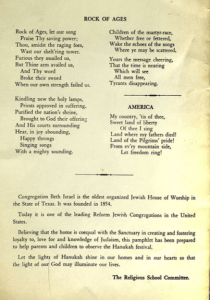Chan ukah (or is that Hanuk(k)ah?) is on our minds this week, as many of us light the candles each night, gather with friends and family to eat latkes and spin dreidels, and exchange gifts. Unlike most Jewish holidays, Chanukah’s central rituals are performed at home, not in synagogue. This distinction necessitated the publication of how-to guides, so that American Jews could faithfully observe Chanukah each night without the watchful presence of a rabbi or cantor to lead them.
ukah (or is that Hanuk(k)ah?) is on our minds this week, as many of us light the candles each night, gather with friends and family to eat latkes and spin dreidels, and exchange gifts. Unlike most Jewish holidays, Chanukah’s central rituals are performed at home, not in synagogue. This distinction necessitated the publication of how-to guides, so that American Jews could faithfully observe Chanukah each night without the watchful presence of a rabbi or cantor to lead them.
One such guide, Congregation Beth Israel’s “Hanukah at Home,” aimed to instruct Jewish Houstonians from Texas’s oldest synagogue in the proper performance of holiday rituals. There is no date printed on the pamphlet, but references to democracy and American values, common during the early years of the Cold War, lead me to suspect that it dates from the late 1940s. “Hanukah at Home” can be found in our collection of Beth Israel archival material, MS 711, available to researchers and community members for viewing in the Woodson Research Center in Rice University’s Fondren Library.
“Hanukah at Home” prescribes rituals that are utterly baffling to the modern reader who is accustomed to contemporary traditions. For one, Beth Israel members were encouraged to dine on cheese pancakes and other dairy delicacies, not potato latkes, which we all think of as the quintessential holiday food. The tradition of eating cheese on Chanukah comes from the story of Judith and Holofernes, and you can read more about it here.
For another, the Beth Israel guide informs the reader that “[g]oose is the traditional main dinner dish during Hanukah, served with potato pudding.” Does a goose feast sound strange to you? It isn’t! Here again, “Hanukah at Home” is documenting a holiday tradition that has been largely lost to history. See Jeffrey Yoskowitz’s New York Times article about the Chanukah goose feast here.
Finally, the guide advises readers to enjoy spinning the “trendel,” not the dreidel – a four-sided top with Hebrew letters on it. According to Rabbi David Golinkin, trendl was a term used by German-speaking Jews to refer to the Chanukah toy, from a word meaning “to roll.” (My thanks to Rabbi Steve Morgen of Beth Yeshurun for helping find this source!) You can read Rabbi Golinkin’s surprising history of the dreidel, and its non-Jewish origins, here.
Most of Beth Israel’s founding members in the mid-19th century claimed ancestry from German-speaking lands, but it is fascinating to see a German term used here in place of the more-familiar dreidel, in a document that seems to date from the 1940s.
There is so much more to say about this guidebook, which encourages readers to sing “Rock of Ages” and “America” each night after candle lighting, and which offers a different theme and set of values for Jewish families to ponder for each night of the holiday. On the first night of Chanukah, as Beth Israel families exchanged gifts, they were asked to keep in their hearts “the thousands of children in the world who are hungry and cold and without the love and warmth of home and friendship.” On the sixth night, readers were called to remember that “every human being, no matter what his color or his race,” is a child of God and deserving of love. 
Looking back in history deepens our appreciation of how customs evolve and endure. From the Houston Jewish History Archive at Rice, best wishes for a joyous holiday, however you choose to celebrate!
For more on the history of Congregation Beth Israel, the oldest synagogue in Texas, visit their website and learn about their wonderful archive here.


